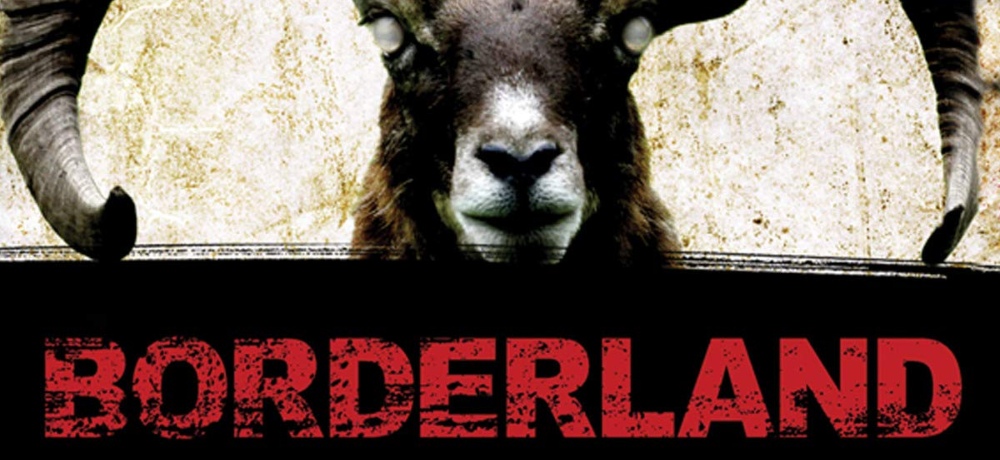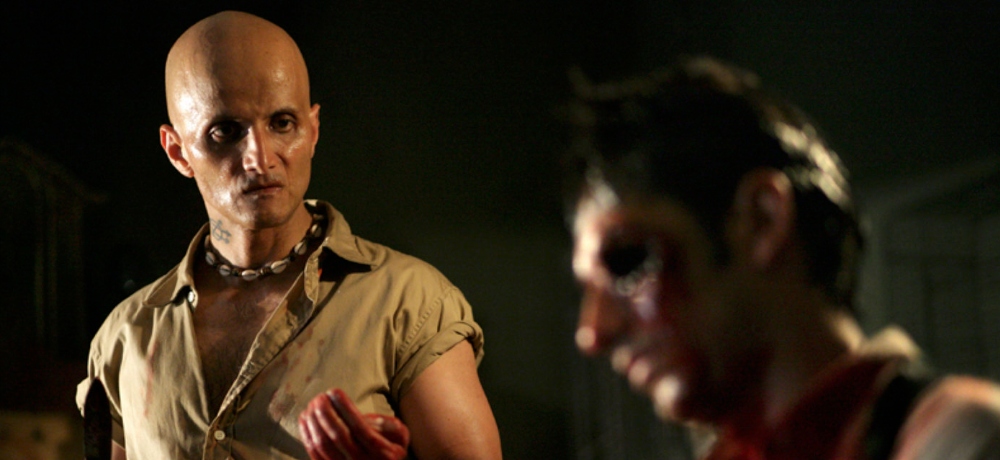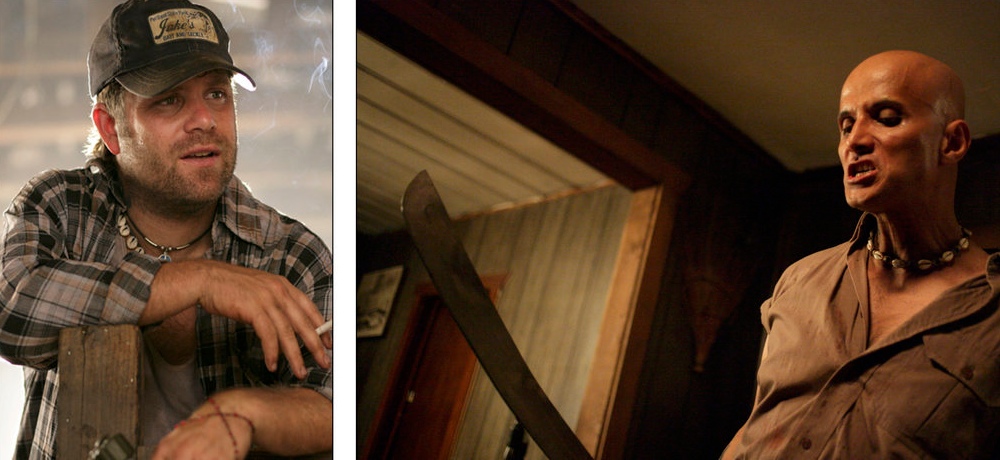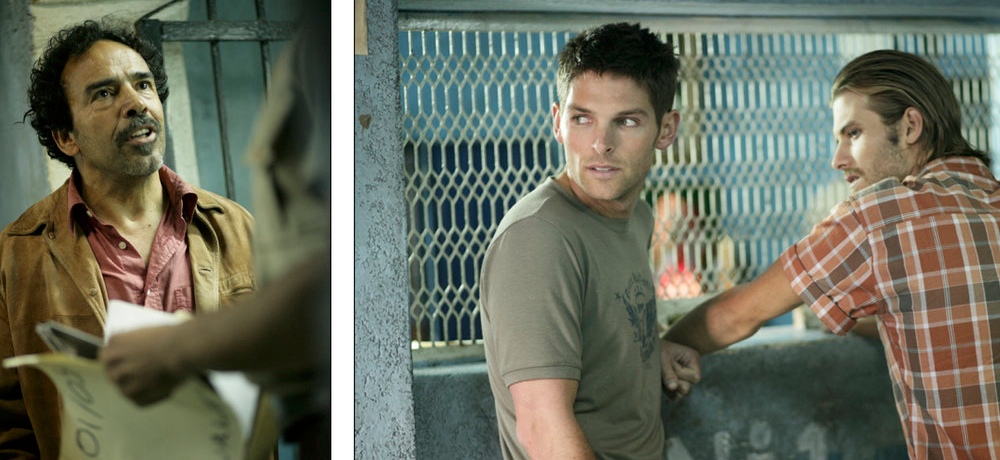


Middle-Earth had come to Minneapolis. There was no doubt about that. Standing in line for Sean Astin’s autograph at Wizard World in 2014, I could see reminders of Peter Jackson’s epic J.R.R. Tolkien adaptations all around me. Everyone else in the long line seemed to be clutching action figures, photographs, and posters featuring Samwise and his Fellowship friends, with the Lord of the Rings celebration interrupted only by the occasional The Goonies or Rudy memorabilia.
As the line inched closer to Astin’s table, I decided that I could safely presume I was one of only a few people without Lord of the Rings memorabilia to be autographed, and I was most likely—okay, very likely—the only one in line holding a DVD copy of the 2007 horror film Borderland to get signed by the beloved actor.
It’s not that I wasn’t a Lord of the Rings fan—seeing The Fellowship of the Ring in theaters is still one of my most treasured and awestruck memories. But there was something truly horrifying about Borderland (or rather, many somethings) that had slithered under my skin, coiled into a warm spot, and stuck with me since I had first seen it several years ago (just a few days before Christmas) as one of the After Dark Horrorfest movies featured on Xfinity.
Under the bright lights of the Minneapolis Convention Center, now only a few people away from meeting Astin, I tried to put my finger on why exactly I was holding a Borderland DVD when there were so many other things I could ask him to sign. Perhaps it was the fact that when I first saw Borderland, I was around the same age as the movie’s three main characters, Ed (Brian Presley), Phil (Rider Strong), and Henry (Jake Muxworthy), a trio of young Texans looking to take one last road trip together just across the border in Mexico before the next phase of college takes them in three very different directions (when I first watched it, I was only months removed from turning the tassel and saying goodbye to a lot of friends from school). Or maybe it was the visceral violence in Borderland that stuck with me, showcased in palpable practical fashion by the legendary KNB EFX Group founded by Robert Kurtzman, Greg Nicotero, and Howard Berger. Or was it Astin’s chilling, very-against-type performance as a remorseless serial killer who teams up with a cult that practices human sacrifices—a cult the three aforementioned friends encounter on their getaway gone wrong?
As it finally became my turn to walk up to Astin’s table, I knew that the movie stuck with me for all of those reasons and more, but there was one additional detail about Borderland that made it especially hard to forget: the fact that it was based on the tragic story of college student Mark Kilroy, who was murdered in 1989 by serial killer Adolfo de Jesús Constanzo, the leader of a cult that conducted human sacrifices in exchange for what they believed was protection from a higher power for their drug-smuggling operation. Following Kilroy's disappearance during spring break in Matamoros just across the border from Brownsville, Texas, a relentless search for the college student ensued. Eventually, Kilroy’s remains (along with the remains of others) were found on a ranch in the Matamoros countryside where Constanzo and his followers had been staying. While the case was solved (and Constanzo was ultimately gunned down in Mexico City), it is not easily forgotten by those who were in that region of Mexico and Texas at that time, including Borderland director Zev Berman, who came in direct contact with the search for Kilroy while on his own road trip in 1989. It was an experience that, much like the movie he wound up directing years later, stuck with him.
“In my 20s, some college friends of mine and I decided to go on a cross-country road trip around the United States,” Zev reflected. “Early on in the trip, we had spent some time in New Orleans and decided to make this road trip from New Orleans down to Mexico City. We were driving in a VW bus, and when we came back up, we were in Brownsville and the Matamoros area right around that time. We ran smack into the manhunt that was going on. We had our VW bus decorated with the voodoo trinkets we picked up in New Orleans, and we passed a roadside inspection station on the Mexico side. They asked us to get out of the car, and all the officers had automatic weapons and we were stood up against a wall. They searched the bus, and they were definitely looking at and examining voodoo trinkets that we'd picked up in New Orleans. They asked if we were Satánicos—Satanists.”
While Zev and his friends were eventually cleared to cross the border, that brush with the aftereffects of Kilroy’s disappearance stayed with Zev even after he returned home.
“That level of scrutiny was definitely the beginning,” Zev continued. “We realized this manhunt was going on, this college student had disappeared, and it really left an impression on all of us, particularly myself. I tracked the story for years, and I ended up getting pretty deep into the story over time. I knew early on that it was something that I wanted to see if I could develop, because it struck home this sense of being in your 20s, feeling invincible, feeling like you can go anywhere, do anything, and running into a story like this. It definitely gave me a pause, and it just seemed to have so many different kinds of cultural resonances: the concept of borders in general, the way that large countries like the United States use borders from an economic and a cultural perspective. The border environments themselves were really unique and unusual.”
Still fascinated by the Kilroy case and Constanzo’s cult years later as a filmmaker, Zev teamed up with his writing partner, Eric Poppen, to continue researching the case while developing a potential movie of their own, one that would explore the type of cult fanaticism that Constanzo and his followers embraced.
“When my writing partner and I were doing research,” Zev reflected, “we were introduced to some of the people in Brownsville who'd been involved in the original case, and that was really helpful. We really wanted to dig into the details. It was Constanzo's story that was of real interest. My writing partner, Eric Poppen, and I were definitely fans of the horror genre, but I'm a bit of a snob when it comes to the kind of horror movies that I love. And I love a lot of them, but I had started to veer away from things that were overtly supernatural. I was really excited by a story that was about the horror of fanatic belief. The fact that from everything we could turn up through research, the people involved on the cartel side were true believers, and Constanzo himself appeared for all intents and purposes to be a true believer. All of his actions that were documented in the media appeared to be the actions of a true believer. And so that in a lot of ways was truly, truly terrifying. There's been a lot of interesting back-and-forth in the horror threads about whether Borderland is truly a horror film, and I would certainly like to say yes, but it definitely doesn't invest in the idea that a supernatural reality is real, but it definitely explores the horror of true believers.”

Following extensive research and the completion of a screenplay that he co-wrote with Eric, Zev began the daunting journey that so many independent filmmakers face: getting his film financed. Thankfully, Zev had a connection from his first feature who would become vital in bringing Borderland to life: producer Lauren Moews, who had produced Zev’s Southern Gothic drama, Plain Dirty (aka Briar Patch), and had recently been one of the producers on Cabin Fever, which was released in theaters across the United States through a distribution deal with Lionsgate—a connection that would prove to be a fortuitous one for Borderland.
“Lionsgate read the script and they were excited,” Zev recalled, “and they ultimately agreed to do a distribution deal with us based on the material and the relationship. We leveraged the distribution deal to raise the money independently, so we had a number of independent investors who came in based on Lionsgate's intent to distribute. George Furla and his business partner, Randall, from Emmett/Furla [Films] were really instrumental in getting the project financed. It was kind of a smaller budget movie than they were typically, historically engaged in. They were able to come in and make the whole thing happen. They brought in investors that they had, including Elisa Salinas. The Salinas family in Mexico is well-known for being involved in media. They own TV Azteca. They played a key role in the project and invested in it as well. So, all of that came together based on Lionsgate's intent to distribute.”
Zev and his team would ultimately garner a budget of $5 million to make Borderland, a sizable budget for an independent film, but still one where you have to make every dollar count.
“You can do a lot with five million,” Zev emphasized, “particularly now. But back then, five million allowed us to shoot on location. We cast all the lead Latin roles out of Mexico City, out of Churubusco Studios, and I had a great camera crew. It was awesome. I'm really grateful we had that kind of budget to work with, because we didn't have to cut a lot of corners.”
With a budget in place, a roster of young stars and veteran actors was assembled, including the aforementioned Astin (just a few years removed from The Lord of the Rings trilogy), renowned actor Damián Alcázar as Ulises (a former police officer looking to take down the sacrificial cult after they killed his partner), and La Ley lead singer Beto Cuevas as Santillan, the cult’s leader who oversees their drug operation and carries out their human sacrifices (the remains of which are placed in his cauldron known as a nganga). Determined to make the film as authentic as possible when it came to its real-life influences (while still not being a direct adaptation of the Kilroy case) and its depiction of life on the border, Zev once again hopped in a van and embarked on a massive location scout along the U.S.-Mexico border, covering 850 miles before settling on where to film.
“The true story happened in Matamoros, which is across from Brownsville, Texas,” Zev reflected, “and we were really intending to shoot there. It was a devastating experience that happened within that town, and by the time we approached the local mayor to ask if they'd be willing to let us shoot there, they decided that they were willing to do it. The problem was we didn't have a lot of close production resources that would support the production. Ultimately, Tijuana was much closer to Los Angeles. So, if cameras went down, we could easily get them replaced. It made a lot more sense logistically to shoot in Tijuana, which worked out great, and I ended up living in Tijuana for over three months.”

For Zev, it was vital that they film Borderland on the U.S.-Mexico border, as the unique beauty, traditions, and atmosphere of border towns couldn’t be authentically replicated on a studio lot.
“The border region in and of itself is fascinating,” Zev said. “A point we tried to make in the movie is that the border town region, it's not the United States and it's not Mexico. It operates under its own set of rules and logic—the collision between two cultures. Border towns are really extraordinary cultural environments where you've got this collision of cultures. Sometimes it can be raw, but sometimes it's beautiful and intense. That was really something that attracted me.”
With Tijuana selected as a filming location, a 30-day shooting schedule commenced, beginning with a brutal eye torture scene that established Zev and KNB EFX Group’s unflinching approach to the movie’s unconventionally realistic violence (in a real-life reflection of the film’s visceral tone, months after filming commenced, Zev learned that someone known as El Pozolero, aka the Stewmaker, had been dissolving bodies in acid for the cartel and disposing of the remains in a graveyard where they filmed one of their scenes). Despite not holding back when it came to showing just how sadistic Santillan’s cult could be, it was vital to Zev that the movie not lose sight of the intense beauty of Mexican border towns and the great people who live there.
“I love Mexico,” Zev said, “I have a deep love for the country, for the people, for those environments.”
When it comes to the characters populating the environments of Borderland, it's Sean Astin’s American serial killer, Randall (partly inspired by real-life serial killer Ottis Toole), who is perhaps the most ruthless member of all in Santillan’s cult. At one point in the film, after Phil is kidnapped by the cult and Randall stands watch in a horse stable, Santillan tells his terrified captive that he does not believe in violence without a purpose, and although he’s tried to pass on this belief to Randall, “…he’s American, so it’s hard.”
Additionally, Jake Muxworthy’s character, Henry, embodies the misguided, xenophobic views of an American with a serious superiority complex, initially viewing the border town as his own playground where he can cut loose without any consequences. Throughout the bloody arc of Borderland, co-writers Zev and Eric show how Henry’s flawed perspective (coupled with his money-first mentality) is not just wrong but ultimately destructive for him and his friends (although too late for his own good, Henry does eventually drop the alpha male American viewpoint in a poignantly tearful scene with Presley’s Ed).
“I have a deep love of Latin culture,” Zev emphasized. “I've traveled extensively in Mexico. I did not go out of my way to make a cautionary tale of, ‘Don't go to Mexico.’ I love the country. When I think of the border region, I see it as a collision between two cultures. I'm interested in the ugly American, which is certainly something that we toyed with, with the Muxworthy character—somebody who is focused on going to business school, who really looks down on Latin culture, who's there primarily for things like drinking and prostitution. He doesn't see it for more than that.”
While some of the American characters are depicted as despicable people in Borderland, Ulises (Alcázar) emerges as the true hero of the film, along with local bartender Valeria (Martha Higareda), who both help Ed on a deadly mission to try to save Phil from being the latest dismembered addition to Santillan’s nganga.

“We were very lucky to work with him [Damián Alcázar],” Zev reflected. “He's won the equivalent of the Mexican Academy Award twice. He's done a lot of really serious films, and he was interested in the way we wanted to treat this. He just lends a lot of credibility to it. The true hero of the story is him in the sense that we get involved in his return to the narrative when he appears in the border town. He's the one who brings down Santillan. That was our attempt to address the American attitudes that aren't particularly positive in the form of Jake's character.”
The showdown between Ulises and Santillan takes place after Phil finds himself the unfortunate guest of honor in the cult’s latest human sacrifice ceremony at the ranch, in which Santillan swaps Phil’s screams for what he believes to be a higher power’s cloaking of his drug-running operation from law enforcement. Similar to the film’s shocking opening, Zev and KNB EFX pushed the envelope even harder in the film’s third act, delivering a sacrifice scene that shook me as much then as it still does now (especially as a lifelong Boy Meets World fan), thanks to Rider Strong’s empathetic performance combined with top-notch effects work from KNB EFX. Their ambitious efforts had a definite impact on the film in post-production, as the unrelenting realism of the sacrifice scene was one of the contributing factors to the MPAA initially giving Borderland an NC-17 rating.
“We had to deliver an R cut, which the studio required,” Zev recalled, “and that was my first experience dealing with the MPAA, because we were a small, independent production. You're left looking at the cut, trying to figure out what you can trim. There was a scene where Rider gets his Achilles tendon chopped, and it used to be a double chop. In the back-and-forth with the MPAA, we found that by trimming one of the chops, they were willing to let it go to a hard R. I think we made one other trim, but it wasn't much more than that.”
Looking back on the film 15 years after it screened at SXSW and After Dark Horrorfest, Zev still has fond memories of the first time he saw an audience react to those visceral scares (and that horrifying ankle slice) at a test screening of Borderland.
“Lionsgate tested the movie in Chatsworth in a huge theater," Zev reflected. "We had about 350 people in the audience. They reached out to people who just wanted to go to the movies and be entertained. When you're part of a test audience, you know you're going in to see something nobody's seen before, so it was just a huge amount of expectation, and to hear people scream and gasp and cheer was amazing. And then during South by Southwest, an amazing festival, we were part of a midnight screening at the Alamo Drafthouse. That was a great memory, I loved being a part of that. Anytime I'm watching something with an audience, I'm barely watching the movie at all. I'm just watching people's faces and watching how they respond. That's enormous fun for me.”
A decade and a half after that test screening, watching Borderland still provokes a stomach-churning response on my repeated viewings, reminding me that the film hasn’t gone anywhere since it first slithered under my skin all those years ago. In fact, the film is more timely now than ever before, as its dissection (at times quite literally) of misguided American perceptions of our global neighbors and the deadly nature of fanatic cult groupthink is perhaps a more vital social commentary in modern times than when Borderland was first released.
Hopefully the next time Sean Astin is at a convention, there will be someone else standing in line with a Borderland DVD or Blu-ray (the Blu-ray includes an insightful documentary that Zev produced about Adolfo Constanzo and the Matamoros killings). Either way, I sure am glad I had that DVD with me back in that Wizard World line in 2014, because when I asked Sean to autograph it, he took the DVD in his hands, smiled, and took a brief detour from Lord of the Rings memory lane to reflect fondly on his gory machete scene in Borderland's finale—just one of many memorable moments from a 2007 horror movie that gets under your skin… and stays there.
---------
Go HERE to catch up on all of our Indie Horror Month 2022 features!
[Image Credits: Above images courtesy of Zev Berman / StoryWorks 360.]